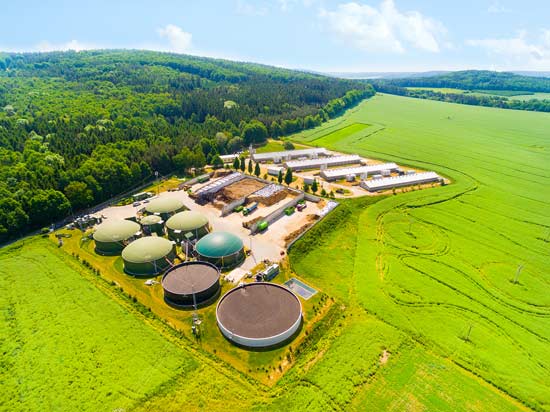Biomass energy is a viable off-grid power solution that harnesses natural resources to generate electricity.
It converts organic matter such as wood, agricultural waste, or even sewage into heat and electricity through various combustion processes.
Biomass energy has gained significant attention in recent years due to its potential to reduce greenhouse gas emissions and reliance on non-renewable fossil fuels.
By adopting biomass technology, individuals and communities can achieve energy independence while supporting sustainable development and mitigating the impact of climate change.
Sources of Biomass
Biomass can be derived from various sources such as agricultural waste, forestry residues, municipal waste, and dedicated energy crops.
Agricultural waste, such as crop residues and waste from animal feeding operations, can be converted into biomass through processes like anaerobic digestion and gasification.
Forestry residues, like wood chips and sawdust, can also be converted into biomass through pyrolysis and gasification.
Municipal waste, consisting of food waste, yard waste, and other organic materials, can be converted into biomass through processes like anaerobic digestion and composting.
Dedicated energy crops, such as switchgrass and miscanthus, are specifically grown for energy production and can be converted into biomass through processes like pyrolysis and gasification.
These sources of biomass can be used to produce biofuels, biochemicals, and biopower, providing a sustainable alternative to fossil fuels.
Harvesting and Collection
Biomass must be harvested and collected in a manner that minimizes contamination and degradation.
Biomass harvesting and collection must be executed with precision to ensure minimal contamination and degradation.
This requires careful planning, efficient execution, and rigorous quality control measures.
First, the location and timing of biomass harvest must be chosen to minimize the risk of contamination from external sources such as soil, water, or other organic matter.
This may involve selecting sites with low levels of environmental pollutants and avoiding harvest during periods of heavy rainfall or extreme temperatures.
Next, the actual harvesting process must be carried out with specialized equipment and techniques that minimize damage to the biomass and prevent contamination.
This may involve using sterile tools, maintaining proper hygiene and sanitation standards, and ensuring that all equipment is properly cleaned and sanitized after use.
The collected biomass must be stored and transported under controlled conditions to prevent degradation and contamination.
This may involve using specialized storage facilities and transportation vessels, as well as implementing quality control measures such as regular sampling and testing.
Storage and Drying
Biomass must be stored and dried to reduce moisture content and prevent spoilage.
Biomass must be stored and dried to reduce moisture content and prevent spoilage.
High moisture levels in biomass can lead to the growth of mold, yeast, and bacteria, which can cause spoilage and reduce the quality and value of the biomass.
When biomass is stored wet, it can also become compressed and lose its volume, making it difficult to handle and process.
Furthermore, excessive moisture can lead to the degradation of the biomass, causing it to lose its nutritional value and potential uses.
Therefore, it is essential to dry biomass to the appropriate moisture content to maintain its quality and ensure its long-term stability.
There are several methods for drying biomass, including air drying, oven drying, and microwave drying.
Each method has its own advantages and disadvantages, and the best method will depend on the type and quantity of biomass being dried, as well as the desired final moisture content.
Air drying is a slow and low-cost method that involves spreading the biomass out in a single layer on a tray or rack and allowing it to dry naturally.
Oven drying is a faster method that involves heating the biomass in a controlled environment, but it can be more expensive and may not be suitable for large quantities of biomass.
Microwave drying is a rapid and efficient method that uses high-frequency electromagnetic waves to heat and dry the biomass, but it can be more expensive and may not be suitable for all types of biomass.
Regardless of the drying method chosen, it is important to monitor the moisture content of the biomass throughout the drying process to ensure that it is dried to the desired final moisture content.
This can be done using a variety of methods, including weight loss measurements, thermogravimetric analysis, and infrared spectroscopy.
It is also important to store the dried biomass in a clean, dry location to prevent spoilage and maintain its quality.
Overall, proper storage and drying of biomass is essential to ensure its quality and prevent spoilage.
By choosing the appropriate drying method and carefully monitoring the drying process, it is possible to produce high-quality dried biomass that can be used for a variety of applications, including fuel, animal feed, and agricultural amendments.
Conversion Technologies
Biomass can be converted into energy through various technologies such as combustion, gasification, pyrolysis, and anaerobic digestion.
Biomass, including organic waste materials such as wood, crop residues, and wastewater sludge, can be converted into energy through a variety of technologies.
Combustion, for example, is a well-established technology that involves burning biomass to produce heat and electricity.
Gasification, on the other hand, is a more advanced technology that involves heating biomass in a controlled environment to produce a synthesis gas, which can then be used to generate electricity or as a fuel.
Pyrolysis is another technology that involves heating biomass in the absence of oxygen to produce bio-oil, which can be used as a direct replacement for fossil fuels.
Anaerobic digestion is a technology that involves breaking down biomass in the absence of oxygen to produce biogas, which is a mixture of methane and carbon dioxide that can be used as a renewable energy source.
Each of these technologies has its own advantages and disadvantages, and the most suitable technology will depend on the specific characteristics of the biomass feedstock and the desired end product.
Combustion
Combustion is the most common method of converting biomass into energy. It involves burning the biomass to produce heat, which can be used to generate steam, generate electricity, or provide heat for industrial processes.
Combustion is the most widely used method for converting biomass into energy, and it involves the burning of biomass to produce heat.
This heat can be used to generate steam, which is then used to power turbines and generate electricity.
The heat generated from combustion can be utilized to provide warmth for industrial processes, such as drying, baking, and other manufacturing activities.
Combustion can be achieved through various methods, including direct combustion, indirect combustion, and pyrolysis.
Direct combustion involves the direct burning of biomass in a furnace or boiler, while indirect combustion involves the burning of biomass in a gasifier or a digester, which produces a gas that is then burned to produce heat.
Pyrolysis, on the other hand, involves the heating of biomass in the absence of oxygen, resulting in the production of pyrolysis oil, which can be used as a fuel or feedstock for the production of other chemicals.
The choice of combustion method depends on the type of biomass being used, the desired end product, and the availability of technologies and resources.
For example, direct combustion is commonly used for forestry residues and agricultural waste, while indirect combustion is often used for municipal waste and other types of biomass that are difficult to burn directly.
Pyrolysis is a promising technology that can be used to produce bio-oil from a wide range of biomass feedstocks, including agricultural waste, forestry residues, and even food waste.
Overall, combustion is a versatile and widely used method for converting biomass into energy.
It offers numerous benefits, including the ability to generate heat and power, reduce greenhouse gas emissions, and create valuable by-products like bio-oil.
However, it also has some drawbacks, such as the potential for air pollution and the need for careful management of ash and other residues.
Nevertheless, with proper planning and execution, combustion can be a highly effective way to convert biomass into energy.
The paragraph above elaborates on the following text: Combustion is the most common method of converting biomass into energy.
It involves burning the biomass to produce heat, which can be used to generate steam, generate electricity, or produce pyrolysis oil, which can be used as a fuel or feedstock for the production of other chemicals.
The choice of combustion method depends on the type of biomass being used, the desired end product, and the availability of technologies and resources.
For example, direct combustion is commonly used for forestry residues and agricultural waste, while indirect combustion is often used for municipal solid waste.
With careful planning and execution, combustion can be a reliable and efficient method of energy conversion.
How does combustion convert biomass into energy?
Combustion is the process of burning biomass to release the chemical energy it contains.
The most common method of combustion is direct combustion, where the biomass is burned in a furnace or boiler to produce heat.
This heat can be used to generate steam, which drives a turbine to produce electricity, or it can be used to produce pyrolysis oil, a mixture of liquids that can be used as a fuel or feedstock for the production of other chemicals.
Indirect combustion is another method, where the biomass is burned in a gasifier, which produces a mixture of gases that can be used to generate electricity or produce other chemicals.
No matter which method is chosen, careful planning and execution are essential to ensure that the combustion process is efficient, reliable, and environmentally friendly.] This paragraph elaborates on the process of combustion as a method of converting biomass into energy.
Combustion involves the burning of biomass to release the chemical energy it contains, and this energy can be used to produce heat, electricity, or other chemicals.
There are two main methods of combustion: direct combustion and indirect combustion.
Direct combustion involves burning the biomass in a furnace or boiler to produce heat, while indirect combustion involves burning the biomass in a gasifier to produce a mixture of gases.
In order to ensure that the combustion process is efficient, reliable, and environmentally friendly, careful planning and execution are essential.
Gasification
Gasification is a process that converts biomass into a mixture of gases, including carbon monoxide, hydrogen, and methane. These gases can be used to generate electricity, produce heat, or fuel vehicles.
Gasification is a versatile and efficient process that transforms biomass into a range of valuable gases, presenting numerous opportunities for sustainable energy production and alternative fuel sources.
By subjecting biomass feedstocks such as agricultural waste, forestry residues, or even municipal solid waste to high temperatures without combustion, gasification produces a mixture of gases that can be tailored to meet specific energy needs.
The resulting gas mixture typically includes carbon monoxide, hydrogen, and methane, each with its own unique properties and applications.
For instance, carbon monoxide can be used as a fuel for power generation, while hydrogen can be utilized as a clean-burning fuel for transportation or industrial processes.
Meanwhile, methane can serve as a feedstock for the production of other important chemicals like fertilizers and plastics.
By leveraging gasification technology, communities and industries can reduce their reliance on fossil fuels, decrease greenhouse gas emissions, and capitalize on an abundant renewable resource.
With careful processing and refining, the gases produced through gasification can provide a reliable and environmentally conscious energy supply that can help meet the evolving needs of a more sustainable future.
Pyrolysis
Pyrolysis is a thermochemical process that involves heating biomass in the absence of oxygen to produce a mixture of gases, liquids, and solids. The produced products can be used as fuels, chemicals, or feedstocks for other industrial processes.
Pyrolysis is a powerful thermochemical process that unlocks the hidden potential of biomass, transforming it into a valuable array of products.
In the absence of oxygen, biomass is heated to high temperatures, causing it to decompose into a mixture of gases, liquids, and solids.
This process produces a rich yield of fuels, chemicals, and feedstocks that can be utilized in various industries.
The gases produced by pyrolysis include bio-oil and syngas, which can be used as fuels for power generation, transportation, and other industrial applications.
The liquids produced are typically bio-oil, which can be used as a direct replacement for fossil fuels.
The solids produced, known as pyrolysis char, can be used as a soil amendment or as a feedstock for other industrial processes.
With its ability to convert waste biomass into valuable products, pyrolysis offers a sustainable solution for the future of energy and industry.
Anaerobic Digestion
Anaerobic digestion is a biological process that involves the breakdown of biomass by microorganisms in the absence of oxygen. The resulting biogas can be used to generate electricity, produce heat, or fuel vehicles.
Anaerobic digestion is a biological process that harnesses the power of microorganisms to break down organic matter in the absence of oxygen.
This process is a highly efficient and sustainable way to convert biomass into valuable energy products.
During anaerobic digestion, microorganisms feast on the biomass, breaking it down into simpler molecules such as carbon dioxide, methane, and water.
The resulting biogas is a mixture of these gases, and it can be used to generate electricity, produce heat, or fuel vehicles.
In fact, anaerobic digestion is already being used to power thousands of homes and businesses around the world, making it an attractive alternative to fossil fuels.
The process produces a nutrient-rich fertilizer that can be used to promote healthy soil and agricultural productivity.
With the growing demand for renewable energy sources, anaerobic digestion is poised to play an increasingly important role in reducing our reliance on fossil fuels and mitigating climate change.
Want More? Dive Deeper Here!
Hey there! If you’re the type who loves going down the rabbit hole of information (like we do), you’re in the right spot. We’ve pulled together some cool reads and resources that dive a bit deeper into the stuff we chat about on our site. Whether you’re just killing time or super into the topic, these picks might just be what you’re looking for. Happy reading!






